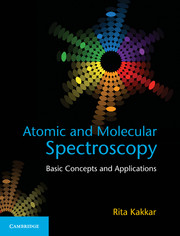Book contents
- Frontmatter
- Dedication
- Contents
- List of Figures
- List of Tables
- Preface
- Acknowledgements
- List of Abbreviations
- 1 Fundamentals of Spectroscopy
- 2 Theoretical Principles
- 3 Atomic Spectroscopy
- 4 Pure Rotational Spectroscopy
- 5 Vibrational Spectroscopy of Diatomics
- 6 Vibrational Spectroscopy of Polyatomic Molecules
- 7 The Raman Effect
- 8 Electronic Spectroscopy of Diatomic Molecules
- 9 Electronic Spectroscopy of Polyatomic Molecules
- Appendix 1 THE SPECTRUM OF THE NON-RIGID ROTATOR
- Appendix 2 CHARACTER TABLES OF SOME IMPORTANT SYMMETRY GROUPS
- References
- Index
6 - Vibrational Spectroscopy of Polyatomic Molecules
Published online by Cambridge University Press: 05 June 2015
- Frontmatter
- Dedication
- Contents
- List of Figures
- List of Tables
- Preface
- Acknowledgements
- List of Abbreviations
- 1 Fundamentals of Spectroscopy
- 2 Theoretical Principles
- 3 Atomic Spectroscopy
- 4 Pure Rotational Spectroscopy
- 5 Vibrational Spectroscopy of Diatomics
- 6 Vibrational Spectroscopy of Polyatomic Molecules
- 7 The Raman Effect
- 8 Electronic Spectroscopy of Diatomic Molecules
- 9 Electronic Spectroscopy of Polyatomic Molecules
- Appendix 1 THE SPECTRUM OF THE NON-RIGID ROTATOR
- Appendix 2 CHARACTER TABLES OF SOME IMPORTANT SYMMETRY GROUPS
- References
- Index
Summary
If you want to find the secrets of the universe, think in terms of energy, frequency and vibration.
—Nikola TeslaIntroduction
We now discuss the complexities that arise for polyatomic molecules. Most of our discussion for diatomic molecules will apply to polyatomic molecules as well, but with two additions. One is the larger number of vibrational degrees of freedom, and the other is the existence of other modes of vibration. For diatomic molecules, the only possible mode of vibration is bond stretching, but the presence of additional internal coordinates (bond angles) makes other kinds of motion, such as bond bending and torsional motion, possible for polyatomic molecules. As in the previous chapters, we will first do an analysis using classical mechanics.
NORMAL MODES OF VIBRATION OF CARBON DIOXIDE
We begin by taking up the normal mode analysis of the linear symmetrical molecule, carbon dioxide, which is easily amenable to both classical and quantum mechanical treatment. From our normal mode analysis for heteronuclear diatomic molecules, we had concluded that the problem is reduced to the diagonalization of the Lagrangian. While the kinetic energy matrix is already in diagonal form, the potential energy matrix is not diagonal because of coupling of motions of the atoms. In order to simultaneously diagonalize both matrices, we had transformed the displacement coordinates to mass-weighted coordinates and then diagonalized the potential energy matrix in this coordinate system to obtain the eigenvalues and eigenvectors. The eigenvalues are related to the natural vibrational frequencies (one in the diatomic case) and the corresponding eigenvectors to the motions in these normal modes. We now apply the method of normal coordinate analysis to another linear, but polyatomic, molecule, carbon dioxide (O=C=O). We again constrain the atoms to move in the bond direction only, which we shall call the z direction.
We label the atoms 1, 2 and 3. Since both bonds are of the same type, i.e., C=O, we would expect both to have identical force constants, say k.
- Type
- Chapter
- Information
- Atomic and Molecular SpectroscopyBasic Concepts and Applications, pp. 231 - 262Publisher: Cambridge University PressPrint publication year: 2015



